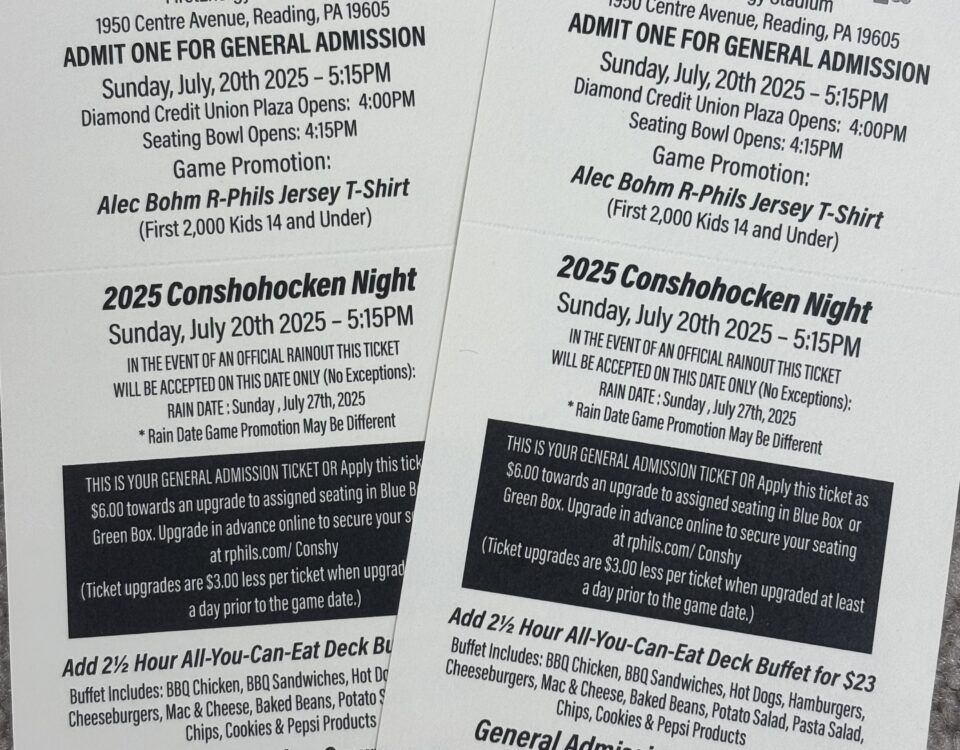
Totaro’s Takes over Sutcliffe Park Snack Stand
May 1, 2021
Were You Born a Dragon? A Book Reading event and more.
May 19, 2021History of a House – 1024 Fayette Street and Two Special Guys who lived there.
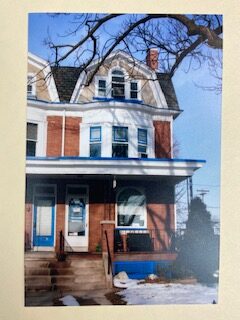
History of a House
1024 Fayette Street
The Story of Robert J. “Hooker” Crawford
And John Stephen Ondik
These were Special Kind of Guys
By Jack Coll
5/5/2021
Editor’s Note: (This is one in a series of short articles on random houses throughout the borough of Conshohocken, enjoy) This is a real piece of Conshohocken history, worth reading twice.
Houses up-and-down the avenues and streets of Conshohocken are, well, today, just houses, but back in the early part of last century, say a hundred years ago many of these houses provided needed services to the community. Many of them were corner stores or mid-block stores, the living rooms of some of these houses doubled as pool rooms, barber shops, cigar stores, candy stores and doctors’ offices. Also some of the town’s most prominent men and women lived in these houses. I thought it might be fun, and interesting to point out of few of these houses, that today are occupied by residents who I’m sure had no idea that their house was at one time something more than just a house.

The twin houses located at 1022 and 1024 Fayette Street were constructed around the turn of last century, (circa 1895). The two and a half story brick and stucco Victorian Colonial Revival style houses were once owned by Roy “Whitey” Ellam at 1022, (more on Roy in a future edition of “History of a House”) and Robert J. “Bob,” “Hooker” Crawford and his wife Emma who lived at 1024 Fayette Street for many years.
Bob Crawford was born in Conshohocken on June 17, 1876 to Joseph and Margaret Crawford and lived his entire life in Conshohocken. Crawford attended Conshohocken Schools and dropped out to take employment with Dr. William M. Hall, who had purchased the property and business from Dr. John Reid at 300 Fayette Street in 1888 where Crawford worked for several years. Crawford left Dr. Hall’s employ for a job with the Adams Express Company. Upon leaving the express company he opened a cigar store at the corner of West Second Avenue and Fayette Street, and so began the legend of Robert “Bob,” “Hooker” Crawford.

Crawford was prominent in a number of fraternal and benevolent organizations but was best known and best remembered for his involvement in the towns sports. As a young teenager during the horse drawn buggy days Crawford was a standout basketball player on the early Conshohocken Pioneer Corps who had won a number of championships from 1894 thru the early 1900’s. He also played on a number of the borough’s football teams and was a brilliant running back where he gained the label as one of the greatest players in the Schuylkill Valley League. He became one of the most feared players in the independent ranks in the eastern part of the state.

In basketball Crawford was an easy choice for a guard position in 1894, Conshohocken was one of the few local teams in the east and games were played with teams in Philadelphia, Camden, Millville and Trenton. From the beginning Conshohocken was recognized as one of the strongest clubs in the sport. During his playing days Crawford would many times play a football game in the afternoon and return to Conshohocken in the evening to play an equally hard basketball game. These early games were very well publicized and games were played before sell-out crowds. Players were said to make between $5.00-15.00 per game, Crawford was at the top of the pay-scale.
When father-time sidelined Crawford as a player he took up managerial reins. In 1914 Crawford organized the Conshohocken professional football team. In the nine seasons that Crawford owned and operated the Conshohocken professional football teams from 1914-1923 he posted a 55-4-15 record including five undefeated seasons. Conshohocken home football games would draw up to 10,000 fans per game at the community Field, (A-Field). (Although most of the games would draw between 6,000-8,000 fans)
Conshohocken’s 1919 team posted a 9-0 record and were named Eastern United States Champions, a team photograph hangs at the National Football Hall of Fame in Canton, Ohio.
Pro football began in 1892 in Pittsburgh, Pennsylvania when former Yale star William “Pudge” Heffelfinger was paid a notable sum of $500 to play in a single game for the Allegheny Athletic Association on November 12. For nearly the next three decades, pro football faced its ups and downs as the game was played primarily in small towns throughout western Pennsylvania and the Midwest.

When the American Professional Football Association was formed in 1920 and renamed the National Football League in 1922, Jim Thorpe, without a doubt the most famous athlete of his time, was named the league’s president, Bob Crawford and his Conshohocken football team was invited to join the National Football League with a number of other small town teams including the Canton Bulldogs, Akron Pros, Cleveland Indians, Rochester Jeffersons among others. The Conshohocken Pros under Bob Crawford at that time was one of the most respected football teams on the professional circuit.
Although the entrance fee into the NFL at that time was a whopping $100 Crawford declined Thorpe’s offer to join the league claiming he didn’t feel the town of Conshohocken could support a National Football League Team in the size of the stadium that they played in, (The Community Field, known as the-A-Field)
When the People’s Club held their annual banquet in January 1917, (the People’s Club was a very prominent Conshohocken club) they honored Bob Crawford with speakers from throughout Montgomery County from Judges to District Attorney’s. One of the speakers was Edwin Harrison, a West Conshohocken textile mill owner who lived at Seventh Avenue and Fayette Street, current site of the CVS Pharmacy. Harrison who himself was a standout baseball and football player spoke of the benefits of sports for all men and boys and urged the attendees to get behind and support a first class athletic field and stressed that a quality field would be a good public investment. A year or two later the community field had a stockade fence built around the field and a covered grandstand but it wasn’t enough to convince Crawford to join the NFL.
Crawfords Cigar Store once located at the corner of East Second Avenue and Fayette Street was a hub of activity for two decades. He purchased the property at Second Avenue and Fayette Street from the Harry estate in 1906 and paid $2,500. Crawford constructed a one story small tin building which became the town’s hot-spot. Steel-workers and employees of the numerous mills along the river would all stop by Crawford’s store on their hike up Fayette Street after working a long shift to get the day’s news before heading home or to stop at one of the many watering holes between the mills and their house.
In the summer of 1916, Crawford took on a new name, “General Hooker.” He was given the title of General Hooker because he had issued a call for volunteers to form a company of infantry to respond to the first call for volunteers should the President of the United States issue a call for volunteers to defend our country. World War I was raging in Europe, (1914-1919) and General Hooker realized that it was a matter of time before the call was issued to Americans to participate in the war effort.
Crawford was prepared to enter the armed forces to help the war effort by leading a contingent of Conshohocken boys. But by 1916 Crawford’s hair was turning gray and he was married, and had seen the better part of 40 years. So he did a better thing , he prepared his “boys” to volunteer. This was brought about at many “Talkfest” in Crawfords Cigar Store, where Conshohocken young men liked to congregate.
As you stepped into Crawford’s store a large American Flag was the first thing you noticed. At that time Crawford explained to them what it means when the country needs young men. As the young men passed through Crawfords store they would listen to him attentively as when he explained how to catch a punt or block a kick.
Crawford was aided by Abe Rosenberger of Harry and Hector Streets. The Lee Tire Employee served in the army for nine years with an honorable record. Tyson Heller of the Counties Gas and Electric Company also agreed to help Crawford with recruiting as he was a former member of the U. S. Marines with twelve years of service.
Less than nine months later on April 2, 1917, President Woodrow Wilson went before a joint session of congress to request a declaration of war against Germany. On April 4, 1917 the United States Senate voted in support of the measure to declare war on Germany.
Bob Crawford put out a call to his recruits that the time had come to defend our country. Just two days after the U.S. Senate voted to support the war effort on April 6, 1917 Crawford’s first contingent of men gathered for a group photograph on the steps of the First Baptist Church located on East Fourth Avenue and Harry Street.

Men posing in front of the First Baptist Church included in the front row from left to right included Francis X. Wood, Albert Allen, John Keenan, George Wood, Herbert Scholes, Charles Smith, Willis Kirkpatrick, recruiting officer; Henry Long, Post Commander: George Dyer, John Crawford, Charles Hartig, Harry Tyson, Samuel Beaver, George Jones and John Dodsworth.
Second Row from left included: Herbert Scholes, John Higgins, Roy Metzgar, Frank Hiltner, Lloyd Behmke, Walter Winters, John Black, and Llewellyn Jones.
Third Row from left included: Joseph Carter, Frank Diesinger, Frank Keiebel, Warren Fisher, Joseph Beaver, John Shade, James McFarland, William Minnis, Walter McGann and Frank Klotzback.
Back Row from left included: Herbert MacFarland, Francis Bobenreith, Robert Walcovic, Charles Quigg, Richard MacFarland, Harold Fernley, James Blake, William Wood, Horace Woodland and William Gallagher.
Following the photograph the men marched up East Fourth Avenue to Fayette Street, down Fayette Street where they were met by thousands of residents cheering them on. They boarded a train at an extremely crowded station taking them to Philadelphia where they transferred to another train that took them to Fort Slocum in New York, it was at Fort Slocum they were trained for combat in France.
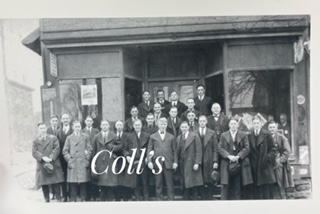
On May 7, 1917 another contingent of men posed in front of Crawford’s cigar store at Second Avenue and Fayette Street, another photograph was snapped in front of Crawford’s store and they too, marched to the train station and they were off to Philadelphia on their way to New York. Just as they did a month earlier girlfriends and family members jammed the passenger cars of the train to ride to Philadelphia giving the recruits a proper sendoff to New York.
At their arrival in Philadelphia a photographer with the Philadelphia Evening Ledger snapped another photograph for the front page of the evening paper with the headline reading:
“CRAWFORD’S CONSHOHOCKEN CAVALRY INVADES CITY.”

Crawford was interviewed for the Philadelphia Ledger newspaper as he stepped from the train. Crawford refused to take any credit for the “Army” that was escorted to the Conshohocken Railway Station on that morning with the marching bands and ringing of the church bells and the tooting of factory whistles.
“The Boys enlisted of their own free will,” he said. “I only tried to encourage them and tell them it was the right thing to do. Others did the same. But I believe most of the Boys would have volunteered anyway. You’ve got to give credit to the Boys. Times were never so prosperous in Conshohocken, and some of the Boys left fine positions to join the Army.
One thing we did that was more important than encouraging the Boys to enlist, that was to tell others not to. We told them that the Army doesn’t want men who work in plants filling government orders. England made a mistake there and had to take its skilled workmen back from the trenches. We must not make that mistake.”
These young Conshohocken recruits going off to war was a big deal in Conshohocken, a few excerpts from the Conshohocken Recorder Newspaper reported back in 1917:
On Thursday May 10, 1917 the second contingent of Conshohocken recruits were part of a massive Fayette Street departure parade. The parade was formed at Second Avenue and Fayette Street down to Marble Street. Thousands of residents lined the short parade route, a number of mills had closed at 8 a. m. including the Alan Wood Steel Company, the John Wood Manufacturing Company, Lee Tire and Rubber Company, and about a dozen other mills along the river.
Both Conshohocken fire companies along with Plymouth Fire Company, Marching bands and a number of local organizations along with Conshohocken’s school children lined the entire parade route all cheering on the departing soldiers.
There were large signs all along the route with one reading, “Population 8010. Watch Us Go,” another read: “Conshohocken First In Recruits, First In Relief.”
The recruits were cheered all along the way and when they reached the train station the crowd was so dense that the recruits were forced to march back to Forrest Street and forced to enter the train station from another direction.
Once the recruits were on the train they could see along the sides of the train tracks workman from the mills lined tightly with signs all cheering and every train station between Conshohocken and Philadelphia were crowded with onlookers cheering for the Conshohocken boys.
The names of the Conshohocken recruits causing all the mass hysteria posing in front of Crawfords Cigar Store included: George W. Haley, Robert H. Peters, Hugh Denny, William J. Morgan, Jr., Joseph Johns, John A. Lawless, (Medical), Harold McCall, (Medical) Charles Cook, Edmund Krojewski, James Jamaela, Olden Vinson, Arthur O’Neill, Frank Chickerine, Dan J. Donovan, William B. Blair, George B. Henderson, (Medical) Francis Blake, Alexander Edry, Harvey I. Dyer, Benny Zbysinski, John Sylawa, Augustave A. Abrams, Charles C. Hanlon, John C. Orniski, Peter Organista, Victor Polkoskee, Edward M. Boyle, Thomas F. Dempsey, Peter Bohmvoski, Harry B. Harrington, William Slukoski, Lewis Piskitive, John Benz, John P. Wertz, James Lestra DeMaris and John S. Hager.
By War’s end it was determined that nearly 1,400 men and women had volunteered to serve our country from Conshohocken and West Conshohocken. Conshohocken had sent more men and women off to war than any other community in America per capita. The Federal Government recognized Conshohocken’s efforts and ordered a Merchant Marine Ship Built at the Chester Ship Yards and the ship was named “The Conshohocken” in honor of the town’s contributions to the war.
Despite a number of other cigar stores in town like William Reilly’s Tobacco Store & Billiard Room located at Tenth Avenue and Spring Mill Avenue and Moore’s Cigar Store on Hector Street and let’s not forget a couple of West Conshohocken very popular cigar stores including Fisher Cigar Store on Ford Street and Peter Maguire’s Tobacco and Candy Store at the corner of Ford and Elizabeth Streets
Crawford made a small fortune at his Second Avenue and Fayette Street location. ( I can’t speak for Crawford but Moore’s, Fisher’s and Maguire’s made their small fortunes during the prohibition era with some of the area’s best moonshine, it was said back in the day that West Conshohocken produced some of the best Hootch on this side of the Mississippi River)
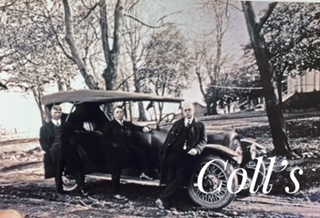
Crawford did well with his money, in the spring of 1916 the Washington Fire Company needed an automobile hose truck to complete its up-to-date fire-fighting equipment and were making arrangements to purchase a chassis and build it into a hose truck. Robert Crawford heard of the firemen’s plans and knowing the company was not rich donated a National 30 horse power chassis.

Over a period of twenty years from 1906 to 1926 Bob Hooker Crawford was one of the most popular and most respected citizens of the town. In January of 1926 Crawford sold his cigar store and empty lots next to the store to the Knights of Columbus. The building and ground was sold for $30,000 and by the spring of 1926 the Knights of Columbus started construction on a three story building. At the rear of the first floor and basement would be a gymnasium that was opened to the public as well as a bowling alley and meeting rooms along with a banquet hall.
The first floor front of the building was used for retail for many years, you might remember Warrells Appliance Store, and they sold everything from car parts, to refrigerators to bicycles.
Once the sale of Crawford’s property was complete Bob retired from business and public life and lived quietly for the next seven years until he passed away at his residence at 1024 Fayette Street in July of 1933.
Crawford was a member of the Conshohocken Free and Accepted Masons and was instrumental in the building and grand opening of the Fritz Lodge # 420 at Eighth Avenue and Fayette Street just a few years before he passed away.
At the time of his death he was survived by his wife Emma, three sisters, Rebecca, wife of Michael O’Brien, of Philadelphia, Mary, wife of Councilman Walter Tomlinson of East Hector Street and Agnes, wife of Richard Copland of East Hector Street and two brothers Joseph of Philadelphia and John of West Conshohocken.
Years later another prominent resident moved into 1024 Fayette Street, John Ondik and his family lived at, and ran his insurance business for four decades out of the rear of 1024 Fayette Street and later moved the insurance company to the main house. Mr. Ondik was yet another resident who contributed greatly to the advancement of Conshohocken with his volunteer work as a Board of Director of the Conshohocken Library. John played a major role for many years in helping to keep the Fellowship House open when the Fellowship House when was an independent arm of the borough.
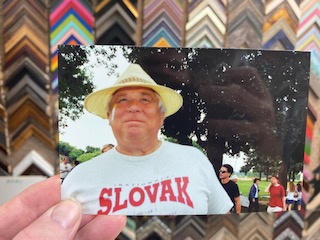
John volunteered for many years with the United Way of Southeastern Pennsylvania where he served as Chairman of the Fund Distribution Committee, it was John serving in this position and his commitment to the Fellowship House that he was able to maintain funding to the facility. This was long before the Borough was able to fund the recreation center.

He was an active member of the Conshohocken Chamber of Commerce and later the Montgomery County Chamber of Commerce, he was an active member of the Conshohocken Professional and Merchants Association, one of the founding membersof the Funfest Committee, an event that carries on to this day, (pre-Covid). He also served as president of the Conshohocken-Plymouth-Whitemarsh Rotary and served on many, many other organizations and committees throughout the borough for many years.
John passed away ten years ago in the winter of 2011 leaving behind his wife Judy and five children John, Michael, Carolyn, Alicia and Judith.
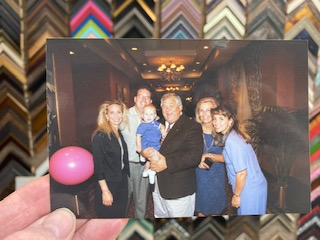
When the book of Conshohocken Borough Leaders is written Bob Crawford and John Ondik will headline the opening chapter. We’re talking about true borough leaders, these guys weren’t afraid to roll their sleeves up and get their hands dirty, these guys would work hard on committees to raise money, they would beg for money and give their own money in support of any project for the good of the community and these types of residents are hard to find today, not to say that they aren’t out there working hard for our borough, but they are few and far between.
And that my friends are the stories of the men who lived at 1024 Fayette Street, a little tip of the cap to Bob “Hooker” Crawford and to an old friend of mine John Ondik. John was a funny man and even after a decade since his passing, I still laugh when I think about John, I wish I could thank him for the memories, perhaps someday I will.
Photographs above include:
1024 Fayette Street, former home to Bob “Hooker” Crawford and John Ondik.
Conshohocken Professional Basketball Team 1896-1897. Bob Crawford is sitting in the front row, center holding the basketball.
Conshohocken’s 1919 Professional Hall-of-Fame Football team, Bob Crawford is standing on the far-left in the back row.
Bob Crawford’s Cigar Store once located at the corner of East Second Avenue and Fayette Street. Odd Fellows Hall can be seen on the left and was built in 1884, Crawford’s store was constructed in 1906 and demolished in 1926.

Bob Crawford poses with a number of mill workers in front of his store at Second Avenue back in 1912 (apparently on a Sunday by the way they are dressed). Crawford is standing at the center of the back row dressed in a white t-shirt. Other men in the photo include Top Row left to right: Bill Lukens, unknown, Crawford, Tommy Pope, unknown, and George Kock.
Middle Row from left: Bill Murray, Henry Wildfire, Joe Shinners. Bottom Row from left: J. Kief, Luke McCall, Chris Montgomery, Andy Lone, Archie Hyde, Cliff Ramey and Jay Pearson.
Crawford relaxing in front of his store at Second Avenue and Fayette Street with a bunch of his patrons Anthony Cianelli of West Second Avenue. Cianelli is seated on the far left next to Bob Crawford.
A group of Crawford’s recruits posing on the steps of the First Baptist Church in April of 1917 preparing to board a train to Philadelphia.
A group of recruits posing in front of Crawford’s Cigar Store on May 7, 1917 also preparing to board a train to Philadelphia, known as “Crawfords Cavalry.”
The photograph and headline that appeared in the Philadelphia Evening Ledger on May 7, 1917. “CRAWFORD’S CONSHOHOCKEN CAVALRY INVADES CITY.”
Standing outside an automobile with a couple of friends included Bob Crawford on the far left, unidentified in the center and William “Bill” Neville who owned a pharmacy once located at First Avenue and Fayette Street, (Most recently where Jimmy Johns was located)Three photographs of our good friend John Ondik and his family including John at Sutcliffe Park, John posing with family members at the Marriot Hotel in West Conshohocken and John at the Conshohocken Library with Dolores Wood and George Snear in the background

